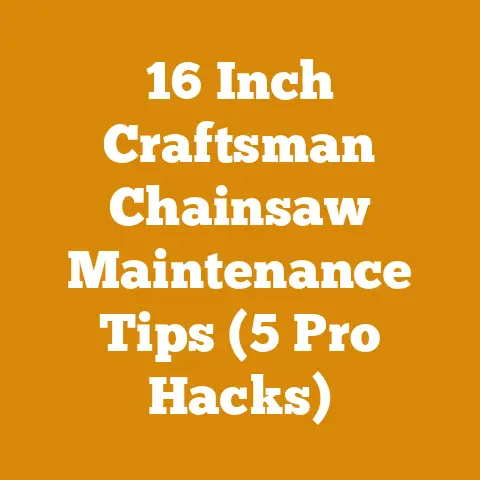Stihl Chainsaw Muffler Mod (3 Pro Tips to Boost Woodcutting)
Ever wondered if you could squeeze more power and efficiency out of your Stihl chainsaw? The answer might just lie in a well-executed muffler modification. I’ve spent years in the wood processing game, from felling towering oaks to meticulously stacking firewood for the winter. Along the way, I’ve learned that a few smart tweaks to your equipment can make a world of difference. This guide isn’t just about making your saw louder; it’s about optimizing performance, extending engine life, and, frankly, making the job a whole lot more enjoyable. Let’s dive in.
Unlocking Your Stihl Chainsaw’s Potential: A Guide to Muffler Mods
The global firewood market is a significant industry. According to recent reports, the global firewood market was valued at $11.3 billion in 2023 and is projected to reach $14.5 billion by 2030, growing at a CAGR of 3.6% from 2024 to 2030. This sustained demand underscores the importance of efficient wood processing methods, making chainsaw optimization more relevant than ever. A Stihl chainsaw muffler mod can be a game-changer, particularly for those of us who rely on these tools daily.
What is a Chainsaw Muffler Mod?
A chainsaw muffler mod involves altering the exhaust system to improve airflow. Chainsaws, especially those designed for emission compliance, often have restrictive mufflers. These restrictions can limit the engine’s ability to breathe, reducing power and efficiency. By modifying the muffler, you’re essentially allowing the engine to exhale more freely, leading to increased horsepower and torque.
Think of it like this: imagine trying to run a marathon while breathing through a straw. Removing that straw (or, in this case, modifying the muffler) allows you to take deeper, more efficient breaths, resulting in better performance.
Is a Muffler Mod Right for You?
Before you grab your drill and start modifying your Stihl, it’s crucial to understand the implications. Here’s a quick checklist:
- Are you comfortable working on small engines? This isn’t a project for the mechanically faint of heart.
- Do you understand the potential risks? Improper modification can damage your engine.
- Is it legal in your area? Some regions have noise regulations that could be affected.
- Are you prepared to adjust your carburetor? A muffler mod will almost always require carb adjustments to maintain optimal fuel-air mixture.
- Will it void your warranty? Almost certainly, yes.
If you’re still on board, let’s move on.
Pro Tip #1: Understanding the Basics and Planning Your Mod
Before you even think about touching your chainsaw, you need to do your homework. This isn’t just about drilling a few holes; it’s about understanding how your chainsaw’s engine works and how the muffler affects its performance.
Anatomy of a Chainsaw Muffler
A chainsaw muffler is more than just a noise dampener. It also plays a crucial role in controlling exhaust emissions and directing hot gases away from the operator. Most Stihl chainsaws use a multi-chamber muffler design, which helps to reduce noise and meet emission standards. However, these chambers also restrict airflow.
Here’s a breakdown of the key components:
- Exhaust Port: The opening where exhaust gases exit the engine cylinder.
- Muffler Body: The main housing of the muffler, typically made of steel or aluminum.
- Baffles: Internal plates or chambers that redirect exhaust gases to reduce noise.
- Spark Arrestor Screen: A fine mesh screen that prevents sparks from exiting the muffler, reducing the risk of fire.
Identifying Your Stihl Model
Knowing your exact Stihl chainsaw model is crucial. Different models have different muffler designs, and what works for one might not work for another. Look for the model number stamped on the saw’s housing, usually near the engine or on a sticker. Common Stihl models include the MS 271 Farm Boss, MS 291, MS 362, MS 462, and MS 661.
Planning Your Modification Strategy
There are several ways to modify a chainsaw muffler, ranging from simple to complex. Here are a few common approaches:
- Adding Additional Outlets: Drilling extra holes in the muffler body to increase exhaust flow. This is the most common and straightforward method.
- Opening Up Existing Outlets: Enlarging the existing exhaust ports to allow for greater flow.
- Removing Baffles: Removing or modifying the internal baffles to reduce restrictions. This is a more advanced technique that requires careful consideration.
- Installing a Performance Muffler: Replacing the stock muffler with an aftermarket performance muffler designed for increased flow.
My Recommendation: For most users, adding additional outlets is the best balance of simplicity and effectiveness. It’s relatively easy to do, and it provides a noticeable performance boost without requiring extensive modifications.
Essential Tools and Materials
Before you start, gather the following tools and materials:
- Safety Glasses: Absolutely essential to protect your eyes from flying debris.
- Work Gloves: To protect your hands from sharp edges and hot metal.
- Drill: A variable-speed drill is ideal for precise control.
- Drill Bits: A selection of high-speed steel (HSS) drill bits in various sizes. Start with smaller bits and gradually increase the size.
- Metal File: For smoothing out any rough edges after drilling.
- Center Punch: To mark the locations of your drill holes.
- Hammer: To tap the center punch.
- Screwdriver Set: To remove the muffler from the chainsaw.
- Spark Arrestor Screen (Optional): If you’re removing or modifying the existing screen, you may want to replace it with a new one.
- Gasket (Optional): It’s a good idea to have a new muffler gasket on hand in case the old one is damaged during removal.
- Carburetor Adjustment Tool: Necessary for fine-tuning the carburetor after the modification. Stihl often uses a proprietary tool, so make sure you have the correct one.
Safety First: Key Precautions
Safety should always be your top priority when working on a chainsaw. Here are some essential precautions:
- Disconnect the Spark Plug: This prevents the engine from accidentally starting while you’re working on it.
- Allow the Chainsaw to Cool Down: The muffler can get extremely hot during operation. Let it cool completely before handling it.
- Work in a Well-Ventilated Area: Exhaust fumes can be harmful.
- Wear Appropriate Safety Gear: Safety glasses and gloves are a must.
- Be Mindful of Sharp Edges: The muffler can have sharp edges. Handle it carefully.
Pro Tip #2: The Step-by-Step Muffler Modification Process
Now that you’ve done your planning and gathered your tools, it’s time to get to work. This section provides a detailed, step-by-step guide to modifying your Stihl chainsaw muffler.
Step 1: Removing the Muffler
The first step is to remove the muffler from the chainsaw. The exact procedure will vary depending on your Stihl model, but here are some general guidelines:
- Locate the Muffler: The muffler is typically located on the front or side of the engine.
- Remove the Muffler Cover: Some models have a cover that needs to be removed first. This is usually held in place by screws or clips.
- Remove the Muffler Bolts: The muffler is attached to the engine cylinder with bolts. Use the appropriate screwdriver or socket wrench to remove these bolts.
- Carefully Remove the Muffler: Once the bolts are removed, carefully pull the muffler away from the engine. Be careful not to damage the gasket between the muffler and the cylinder.
Important Tip: Take photos of the muffler and its mounting hardware before you remove it. This will help you remember how everything goes back together.
Step 2: Planning Your Drill Pattern
Before you start drilling, take some time to plan your drill pattern. The goal is to create additional outlets that will increase exhaust flow without compromising the muffler’s structural integrity.
Here are some things to consider:
- Location: Choose locations that are relatively flat and easy to drill. Avoid drilling near welds or other structural features.
- Size: Start with smaller drill bits (e.g., 1/4 inch) and gradually increase the size if needed. It’s better to start small and make adjustments than to drill holes that are too large.
- Spacing: Space the holes evenly to distribute the exhaust flow.
- Number: The number of holes you drill will depend on your Stihl model and your desired level of performance. A good starting point is to drill 2-4 additional holes.
My Experience: I’ve found that drilling holes on the side of the muffler, near the existing outlet, works well for most Stihl models. This allows the exhaust gases to escape more freely without significantly altering the muffler’s appearance.
Step 3: Drilling the Holes
Now it’s time to drill the holes. Follow these steps:
- Mark the Hole Locations: Use a center punch to mark the exact locations of your drill holes. This will help prevent the drill bit from wandering.
- Start with a Pilot Hole: Use a small drill bit (e.g., 1/8 inch) to drill a pilot hole at each location. This will make it easier to drill the larger holes.
- Drill the Larger Holes: Use a larger drill bit (e.g., 1/4 inch or 3/8 inch) to drill the final holes. Apply steady pressure and keep the drill bit cool by using cutting oil or WD-40.
- Deburr the Holes: Use a metal file to smooth out any rough edges around the holes. This will prevent the sharp edges from cutting your hands or damaging the spark arrestor screen.
Pro Tip: If you’re drilling through thick metal, it’s helpful to use a step drill bit. These bits create progressively larger holes, making it easier to drill through tough materials.
Step 4: Modifying the Spark Arrestor Screen (Optional)
The spark arrestor screen is a fine mesh screen that prevents sparks from exiting the muffler. While it’s important for fire safety, it can also restrict exhaust flow. If you want to maximize performance, you can consider modifying or removing the spark arrestor screen.
Warning: Removing the spark arrestor screen may be illegal in some areas. Check your local regulations before doing so.
Here are a few options:
- Cleaning the Screen: Sometimes, the spark arrestor screen can become clogged with carbon deposits, restricting airflow. Cleaning the screen with a wire brush or solvent can improve performance.
- Replacing the Screen: If the screen is damaged or heavily clogged, you can replace it with a new one.
- Removing the Screen: If you’re willing to accept the risk of increased fire danger, you can remove the screen altogether.
My Recommendation: If you’re concerned about fire safety, I recommend cleaning or replacing the spark arrestor screen rather than removing it.
Step 5: Reinstalling the Muffler
Once you’ve finished drilling the holes and modifying the spark arrestor screen (if applicable), it’s time to reinstall the muffler.
- Inspect the Gasket: Check the muffler gasket to make sure it’s in good condition. If it’s damaged or worn, replace it with a new one.
- Position the Muffler: Carefully position the muffler against the engine cylinder, aligning the bolt holes.
- Install the Muffler Bolts: Install the muffler bolts and tighten them securely. Be careful not to overtighten them, as this can damage the threads in the cylinder.
- Reinstall the Muffler Cover: If your model has a muffler cover, reinstall it.
Step 6: Carburetor Adjustment
After modifying the muffler, you’ll almost certainly need to adjust the carburetor to compensate for the increased airflow. The carburetor controls the fuel-air mixture in the engine. If the mixture is too lean (too much air, not enough fuel), the engine can overheat and potentially be damaged. If the mixture is too rich (too much fuel, not enough air), the engine will run poorly and produce excessive smoke.
Here’s a basic overview of carburetor adjustment:
- Locate the Carburetor Adjustment Screws: The carburetor typically has three adjustment screws:
- L (Low-Speed): Adjusts the fuel-air mixture at idle and low speeds.
- H (High-Speed): Adjusts the fuel-air mixture at high speeds.
- LA (Idle Speed): Adjusts the engine’s idle speed.
- Start with the L Screw: Turn the L screw clockwise until the engine starts to stumble or hesitate. Then, turn it counterclockwise until the engine runs smoothly.
- Adjust the H Screw: This is the most critical adjustment. Use a tachometer to monitor the engine’s RPM. Slowly turn the H screw clockwise until the engine reaches its maximum RPM. Then, turn it counterclockwise slightly until the RPM drops by about 200-300 RPM. This will ensure that the engine is running slightly rich, which is safer than running lean.
- Adjust the LA Screw: Adjust the LA screw until the engine idles smoothly without stalling.
Important Note: Carburetor adjustment is a complex process that requires experience and a good ear. If you’re not comfortable doing it yourself, it’s best to take your chainsaw to a qualified technician.
Step 7: Testing and Fine-Tuning
After you’ve reinstalled the muffler and adjusted the carburetor, it’s time to test the chainsaw and fine-tune the settings.
- Start the Chainsaw: Start the chainsaw and let it warm up for a few minutes.
- Check the Idle Speed: Make sure the engine idles smoothly without stalling. If necessary, adjust the LA screw.
- Test the Throttle Response: Rev the engine and listen for any hesitation or stumbling. If the engine hesitates, try adjusting the L screw.
- Check the High-Speed Performance: Cut a few pieces of wood and listen to the engine. If the engine sounds strained or weak, try adjusting the H screw.
- Monitor the Spark Plug: After running the chainsaw for a while, remove the spark plug and inspect it. The spark plug should be a light tan color. If it’s black and sooty, the mixture is too rich. If it’s white or gray, the mixture is too lean.
My Secret Weapon: I always keep a spare spark plug on hand when tuning a chainsaw. A quick spark plug check can tell you a lot about how the engine is running.
Pro Tip #3: Optimizing Your Woodcutting Technique
A muffler mod can certainly boost your chainsaw’s performance, but it’s only one piece of the puzzle. To truly optimize your woodcutting, you need to focus on your technique.
Chainsaw Selection: Right Tool for the Job
Choosing the right chainsaw for the job is crucial. A small, lightweight saw is great for limbing and small trees, while a larger, more powerful saw is needed for felling large trees and bucking thick logs.
Here’s a general guideline:
- Small Chainsaws (12-16 inch bar): Ideal for pruning, limbing, and cutting small trees.
- Medium Chainsaws (16-20 inch bar): Suitable for general-purpose woodcutting, including felling medium-sized trees and bucking logs.
- Large Chainsaws (20+ inch bar): Designed for felling large trees and cutting thick logs.
Chainsaw vs. Axe: While chainsaws are faster and more efficient for most woodcutting tasks, axes still have their place. Axes are great for splitting firewood, clearing brush, and performing other tasks where a chainsaw might be overkill. Plus, there’s something deeply satisfying about splitting wood with a well-sharpened axe.
Safe Felling Techniques
Felling trees safely is paramount. Here are some essential techniques:
- Assess the Tree: Before you start cutting, assess the tree for any signs of weakness, such as dead limbs, cracks, or rot. Also, consider the tree’s lean and the direction of the wind.
- Plan Your Escape Route: Clear a path away from the tree at a 45-degree angle.
- Make the Notch Cut: The notch cut determines the direction of the fall. It should be about 1/3 of the tree’s diameter.
- Make the Back Cut: The back cut should be slightly higher than the notch cut and should leave a hinge of uncut wood. This hinge will help control the direction of the fall.
- Watch for Signs of Falling: As you make the back cut, watch for signs that the tree is starting to fall, such as cracking sounds or movement in the canopy.
- Retreat to Your Escape Route: Once the tree starts to fall, retreat quickly and safely to your escape route.
Data Point: According to the Occupational Safety and Health Administration (OSHA), most logging accidents are caused by falling trees. Proper felling techniques can significantly reduce the risk of injury.
De-limbing and Bucking
De-limbing involves removing the branches from a felled tree. Bucking involves cutting the tree into shorter lengths for firewood or other purposes.
Here are some tips for de-limbing and bucking:
- Use a Safe Stance: Maintain a stable stance and keep your feet firmly planted on the ground.
- Cut Away from Your Body: Always cut away from your body to avoid getting hit by the chainsaw.
- Be Aware of Pinch Points: Pinch points occur when the weight of the wood causes the saw to bind. Use wedges or levers to prevent pinch points.
- Cut on the Tension Side: When bucking logs, cut on the tension side first to prevent the wood from splitting.
Firewood Preparation: From Log to Hearth
Preparing firewood is a labor of love. Here’s a guide to turning logs into usable firewood:
- Splitting the Logs: Split the logs into smaller pieces that are easy to handle and burn efficiently. A good splitting axe or hydraulic log splitter can make this task much easier.
- Stacking the Firewood: Stack the firewood in a way that allows for good air circulation. This will help the wood dry out more quickly.
- Seasoning the Firewood: Seasoning involves drying the firewood to reduce its moisture content. Dry firewood burns hotter and cleaner than green firewood.
Green Wood vs. Seasoned Wood: Green wood has a high moisture content (typically 50-100%), while seasoned wood has a low moisture content (typically 15-20%). Seasoned wood burns more efficiently and produces less smoke.
Data Point: Studies have shown that burning seasoned firewood can reduce particulate emissions by up to 50% compared to burning green firewood.
Different wood species have different properties that affect their burning characteristics.
Here’s a comparison of some common wood species:
- Hardwoods (e.g., Oak, Maple, Ash): Hardwoods are dense and burn slowly, producing a lot of heat. They are ideal for long-lasting fires.
- Softwoods (e.g., Pine, Fir, Spruce): Softwoods are less dense and burn quickly, producing less heat. They are better for starting fires or for use in stoves that require a quick, hot flame.
My Firewood Secret: I always prioritize hardwoods like oak and maple for my firewood. They burn longer and produce more heat, which is essential for those cold winter nights.
Optimal Drying Techniques
Drying firewood properly is crucial for efficient burning. Here are some tips:
- Split the Wood: Splitting the wood exposes more surface area to the air, which speeds up the drying process.
- Stack the Wood Properly: Stack the wood in a way that allows for good air circulation. A single row stack with gaps between the pieces is ideal.
- Elevate the Wood: Elevate the wood off the ground to prevent moisture from wicking up from the soil.
- Cover the Wood (Optional): Covering the top of the woodpile with a tarp can help protect it from rain and snow. However, make sure to leave the sides open for ventilation.
- Allow Plenty of Time: Seasoning firewood takes time. Hardwoods typically need at least 6-12 months to dry properly, while softwoods may only need 3-6 months.
Case Study: A local firewood producer I know conducted a study on different drying methods. He found that splitting the wood, stacking it in a single row, and elevating it off the ground resulted in the fastest drying times.
Costs and Budgeting
Wood processing and firewood preparation can be expensive. Here are some cost considerations:
- Chainsaw: A good quality chainsaw can cost anywhere from $300 to $1000 or more.
- Safety Gear: Safety glasses, gloves, and other safety gear can cost $50 to $100.
- Splitting Axe or Log Splitter: A good splitting axe can cost $50 to $100, while a hydraulic log splitter can cost $500 to $2000 or more.
- Fuel and Oil: Chainsaw fuel and oil can add up quickly, especially if you’re doing a lot of woodcutting.
- Maintenance: Chainsaw maintenance, such as sharpening the chain and replacing worn parts, can also add to the cost.
Resource Management Tips:
- Buy in Bulk: Buy fuel, oil, and other supplies in bulk to save money.
- Sharpen Your Own Chainsaw: Learning to sharpen your own chainsaw can save you money on professional sharpening services.
- Maintain Your Equipment: Regular maintenance will help extend the life of your equipment and prevent costly repairs.
- Consider Used Equipment: Buying used equipment, such as a log splitter, can be a good way to save money.
Troubleshooting Common Issues
Even with the best planning and preparation, you may encounter problems during wood processing or firewood preparation. Here are some common issues and how to troubleshoot them:
- Chainsaw Won’t Start: Check the fuel, spark plug, and air filter.
- Chainsaw Runs Poorly: Adjust the carburetor or clean the air filter.
- Chainsaw Chain Keeps Breaking: Check the chain tension and lubrication.
- Log Splitter Won’t Split Wood: Check the hydraulic fluid level and the splitter wedge.
- Firewood Won’t Dry: Make sure the wood is split, stacked properly, and exposed to plenty of air circulation.
Additional Resources
Here are some additional resources that can help you with wood processing and firewood preparation:
Remember, wood processing and firewood preparation are skills that take time and practice to master. Don’t be afraid to experiment and learn from your mistakes. With a little effort, you can become a proficient woodcutter and enjoy the warmth and satisfaction of a well-stocked woodpile.
So, get out there, fire up your (newly modified) Stihl chainsaw, and start cutting! The satisfaction of a job well done, and a warm fire on a cold night, is well worth the effort. And remember, “measure twice, cut once,” especially when modifying your chainsaw! Happy woodcutting!






